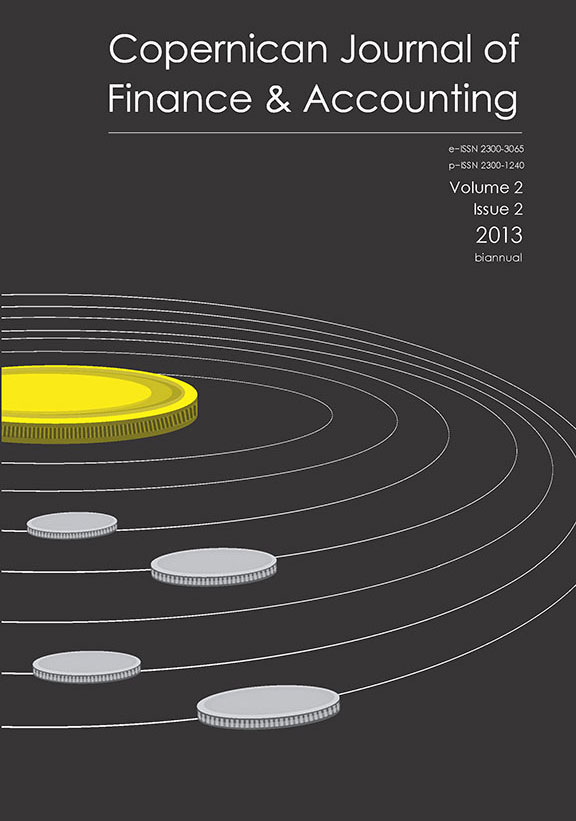Money illusion – the essence, social and economic costs and ways of their reduction in the light of sustainable development concept
DOI:
https://doi.org/10.12775/CJFA.2013.015Keywords
money illusion, sustainable development, behavioral financeAbstract
To be deceived, only or mainly, by nominal monetary categories while undertaking economic decisions, what is called a money illusion, may generate serious economic disturbances. In the light of sustainable development concept, it is negative phenomenon that may destabilize economic and social orders. It works mainly through distortion of income distribution among society and deepening market imbalances in time of crisis. Therefore, it is desirable to undertake activities that lead to reduction of money illusion, with special regard to the policy of state that supports stability of money purchasing power together with parallel intensive education of society about mechanics of money illusion, starting from secondary school level.
References
Akerlof G. A., Yellen J. (1985), Can Small Deviations from Rationality Make Significant Differences to Economic Equilibria?, “American Economic Review”, LXXV.
Brunnermeier M. K., Julliard Ch. (2008), Money Illusion and Housing Frenzies, “The Review of Financial Studies”, vol. 21, no. 1. doi: http://dx.doi.org/10.1093/rfs/hhm043.
Campbell J. Y., Shiller R. J. (1996), A scorecard for indexed government debt, National Bureau of Economic Research, “Working Paper Series”, no. 5587. doi: http://dx.doi.org/10.2307/3585195.
Cohen R. B., Polk Ch., Vuolteenaho T. (2005), Money Illusion In The Stock Market: The Modigliani-Cohn Hypothesis, “National Bureau of Economic Research, Working Paper”, 11018. http://dx.doi.org/10.1093/qje/120.2.639.
Cover J. P. (1992), Asymmetric Effects of Positive and Negative Money-Supply Shocks, “Quarterly Journal of Economics”, November, 107 (4). doi: http://dx.doi.org/10.2307/2118388.
DeLong J. B., Summers L. H. (1988), How Does Macroeconomic Policy Affect Output?, “Brookings Papers on Economic Activity”, 2.
Fehr E., Tyran J.-R. (2001), Does Money Illusion Matter?, “The American Economic Review”, vol. 91, no. 5. doi: http://dx.doi.org/10.1257/aer.91.5.1239.
Fehr E., Tyran J.-R. (2004), Money Illusion and Coordination Failure, Institute for Empirical Research in Economics, University of Zurich, “Working Paper”, no. 177. doi: http://dx.doi.org/10.2139/ssrn.495402.
Fisher I. (1928), The Money Illusion, Adelphi, New York.
Garcia J. A., van Rixtel A. (2007), Inflation-Linked Bonds From a Central Bank Perspective, European Central Bank, “Occasional Paper Series”, no. 62.
Haltiwanger J., Waldman M. (1985), Rational Expectations and the Limits of Rationality: An Analysis of Heterogeneity, “American Economic Review”, LXXV.
Harkness J. (1978), The Neutrality of Money in Neoclassical Growth Models, “The Canadian Journal of Economics” / “Revue canadienne d'Economique”, vol. 11, no. 4. doi: http://dx.doi.org/10.2307/134374.
Howitt P. (1987), Money Illusion, [w:] The New Palgrave Dictionary of Economics, vol. 3, J. Eatwell, M. Milgate, P. Newman (eds.), New York.
Hull Z. (2011), Wprowadzenie do filozofii zrównoważonego rozwoju, [w:] Zasady kształtowania postaw sprzyjających wdrażaniu zrównoważonego rozwoju, W. Tyburski (red.), Wyd. Naukowe UMK, Toruń.
Modigliani F., Cohn R. (1979), Inflation, rational valuation, and the market, “Financial Analysts Journal”, 35 (3), 24–44. doi: http://dx.doi.org/10.2469/faj.v35.n2.24.
Noussair Ch. N., Richter G., Tyran J.-R. (2008), Money Illusion and Nominal Inertia in Experimental Asset Markets, Department of Economics University of Copenhagen, “Discussion Papers”, no. 8–29. doi: http://dx.doi.org/10.2139/ssrn.1307717.
Raghubir P., Srivastava J. (2002), Effect of Face Value on Product Valuation in Foreign Currencies, “Journal of Consumer Research”, vol. 29. doi: http://dx.doi.org/10.1086/344430.
Russell T., Thaler R. (1985), The Relevance of Quasi Rationality in Competitive Markets, “American Economic Review”, LXXV. doi: http://dx.doi.org/10.1017/CBO9780511598951.025.
Sargent T. J. (2007), Rational Expectations, [w:] Concise Encyclopedia of Economics, D. R. Henderson (ed.), The Library of Economics and Liberty, 2nd ed., Indianapolis. Patrz też: http://www.econlib.org/library/Enc/RationalExpectations.html
Shafir E., Diamond P., Tversky A. (1997), Money Illusion, “The Quarterly Journal of Economics”, vol. 112, no. 2. http://dx.doi.org/10.1162/003355397555208.
Thaler R. (1992), The Winner’s Curse, The Free Press, New York. doi: http://dx.doi.org/10.1257/jep.2.1.191.
Tobin J. (1972), Inflation and Unemployment, “American Economic Review”, 62 (1).
Downloads
Published
How to Cite
Issue
Section
Stats
Number of views and downloads: 468
Number of citations: 0



